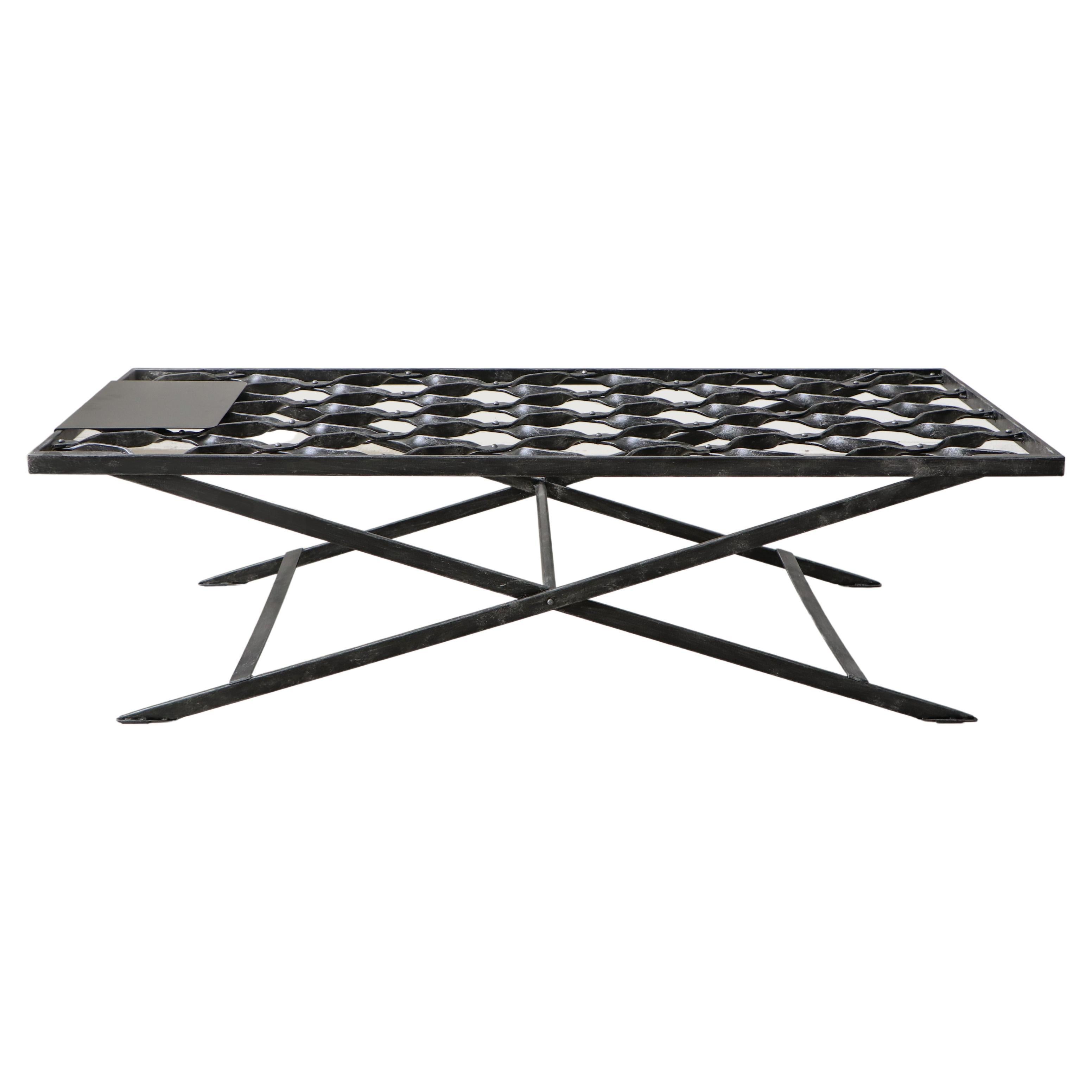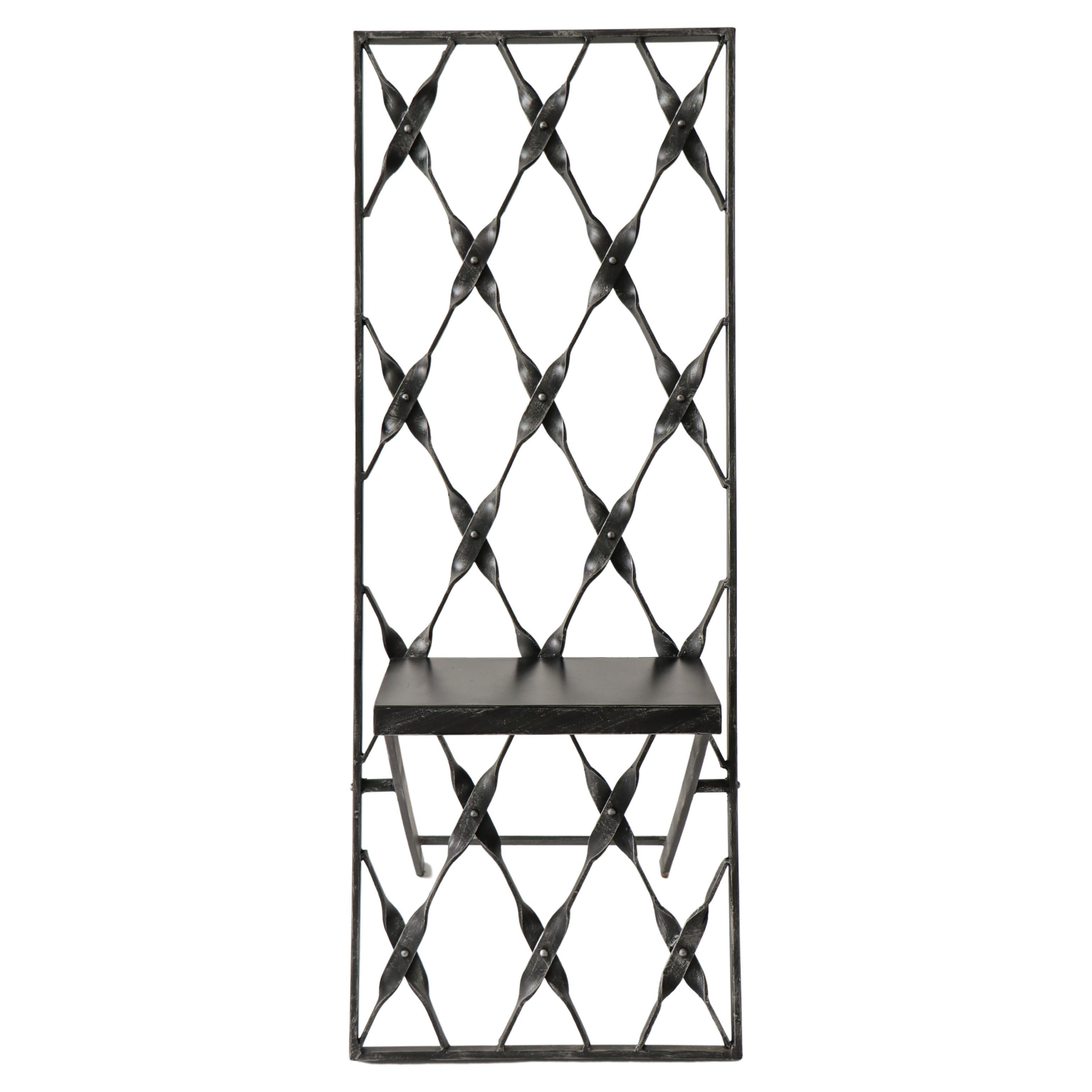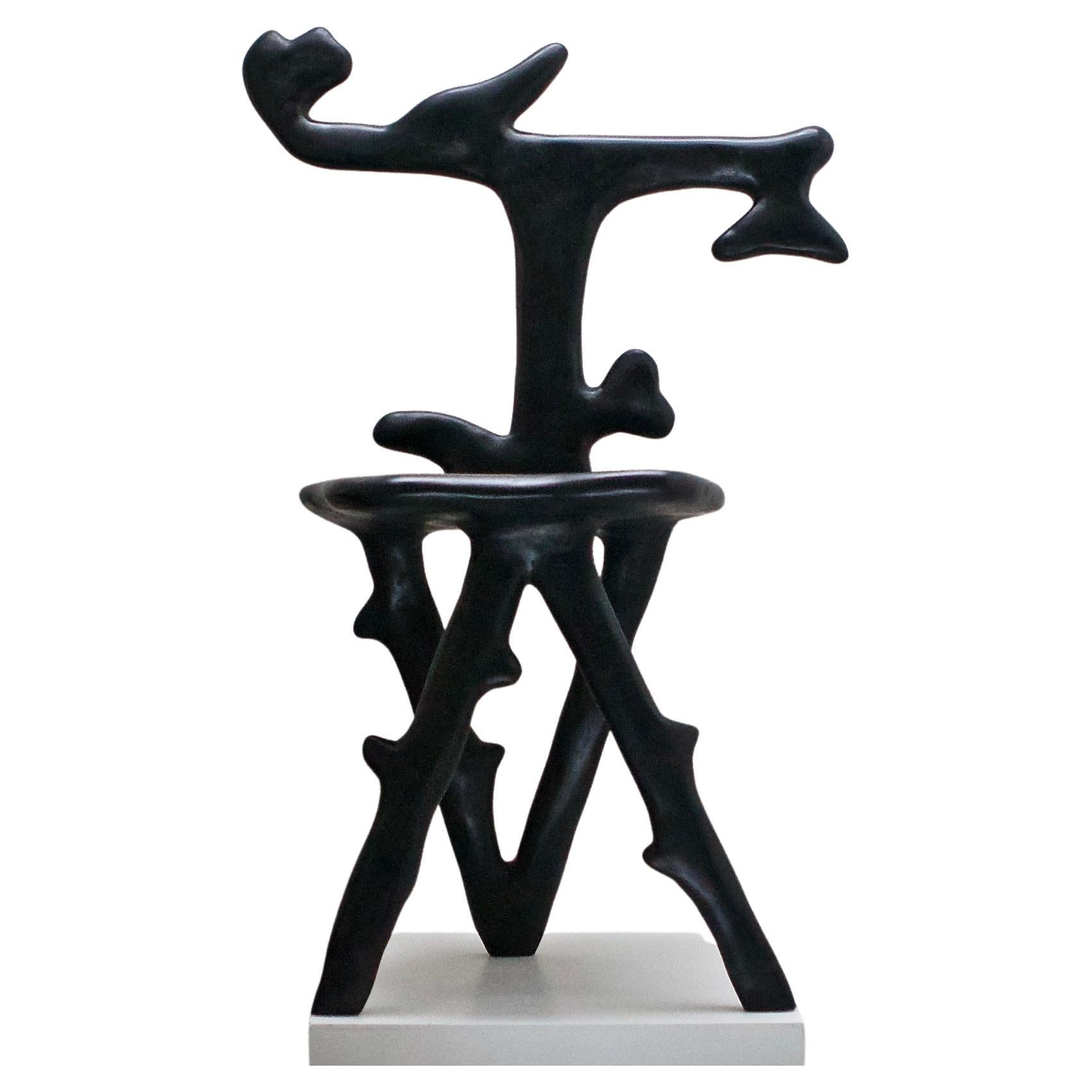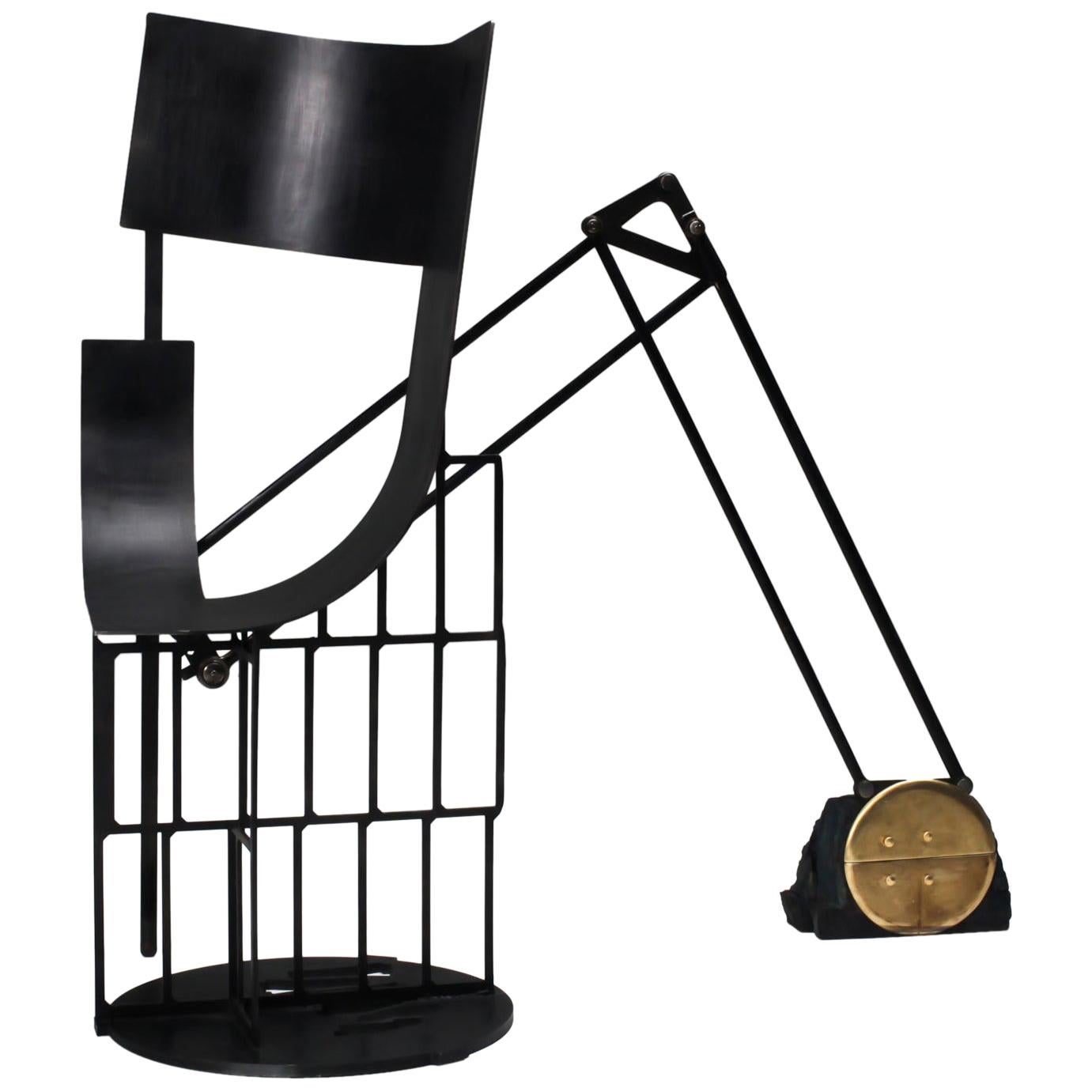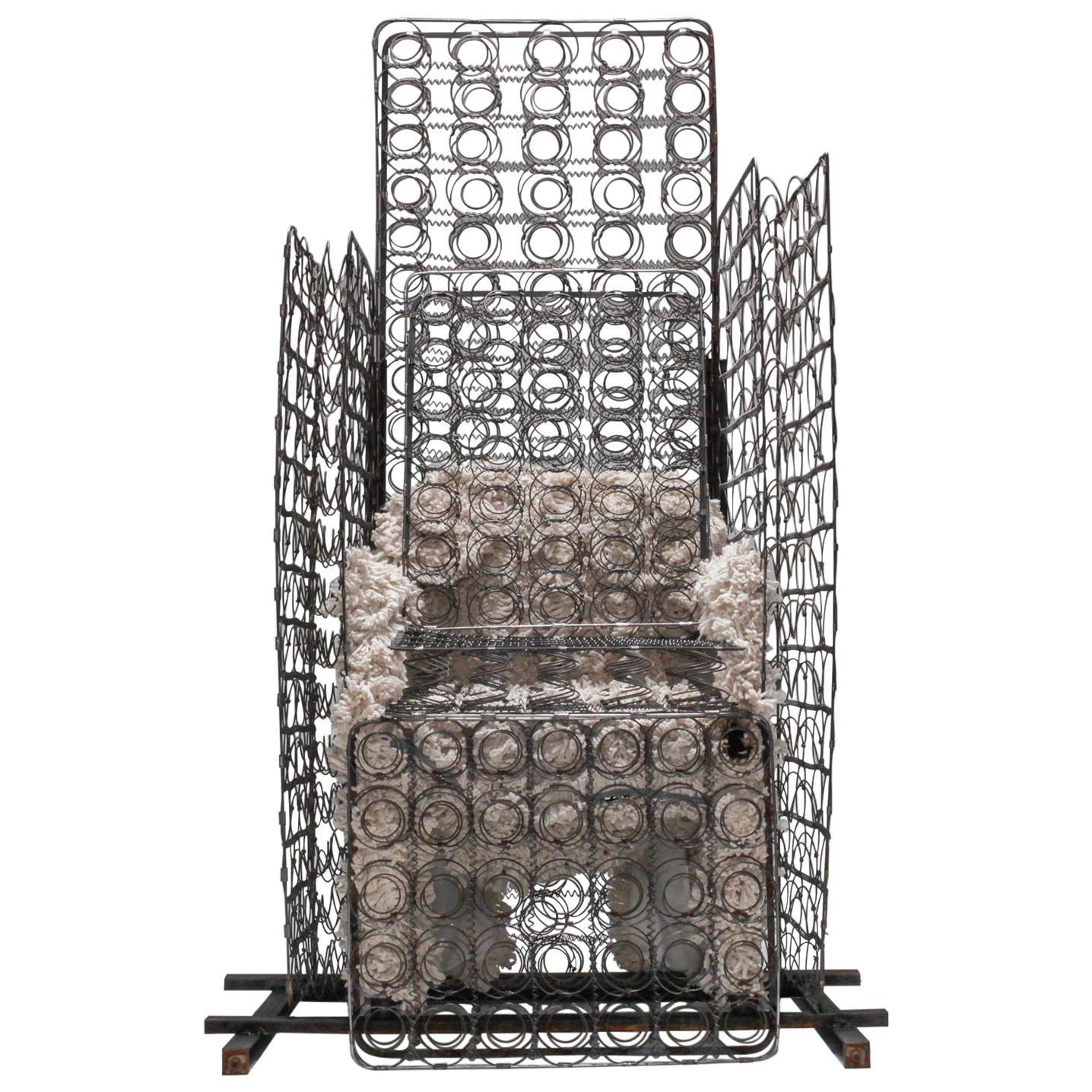Items Similar to Sculptural Black Iron Handcrafted Functional Art Chair
Want more images or videos?
Request additional images or videos from the seller
1 of 12
Sculptural Black Iron Handcrafted Functional Art Chair
About the Item
Escenario Mediterráneo is a collection that evokes the land of the designer, using handcrafted wrought iron as the only material, the creator shows the love for iron craftsmanship in the two collection objects: a low chair and a basket.
The low chair is a piece of art where the seat is a flower-riveted iron mesh structure. It can be used as decoration and as a low seat.
- Dimensions:Height: 27.56 in (70 cm)Width: 21.66 in (55 cm)Depth: 21.66 in (55 cm)Seat Height: 11.82 in (30 cm)
- Materials and Techniques:
- Place of Origin:
- Period:
- Date of Manufacture:2022
- Production Type:New & Custom(Limited Edition)
- Estimated Production Time:4-5 weeks
- Condition:
- Seller Location:València, ES
- Reference Number:1stDibs: LU6198228371642
Cristina Omarrementería
Born in 1988, self-taught, Cristina creates from a romantic perspective; her designs are made only from classic materials such as wrought iron, natural stone and glass. Seduced by the elegant decadence of Mediterranean cities, she lives and works in Valencia, Spain, where she finds the talent of the artisans she works with. The constant aesthetic and intellectual research leads her to always add a psychological component to the objects she creates and to mix meaning and matter, tradition and fantasy, drama and pragmatism, to create unique furniture.
Black and Brown
About the Seller
No Reviews Yet
Vetted Seller
These experienced sellers undergo a comprehensive evaluation by our team of in-house experts.
Established in 2019
1stDibs seller since 2022
5 sales on 1stDibs
- ShippingRetrieving quote...Ships From: València, Spain
- Return PolicyThis item cannot be returned.
More From This SellerView All
- Sculptural Brown Iron Handcrafted Functional Art ChairLocated in València, ESEscenario Mediterráneo is a collection that evokes the land of the designer, using handcrafted wrought iron as the only material, the creator shows the love for iron craftsmanship in...Category
2010s Spanish Chairs
MaterialsIron, Wrought Iron
- Sculptural Brutal Black Iron Daybed Functional Art Wrought IronLocated in València, ESThe Fierro collection shows the magnificence of wrought iron. Through this sculptural bed, the artist wants to express the sensual attractiveness of the strength of this eternal mate...Category
21st Century and Contemporary Spanish Daybeds
MaterialsIron, Wrought Iron, Metal
- Sculptural Black Iron Chair Contemporary Design in Wrought IronLocated in València, ESThe Fierro chair is a functional brutal style piece, made 100% of wrought iron using a traditional artisanal manufacturing process. Through this s...Category
21st Century and Contemporary Spanish Chairs
MaterialsIron, Wrought Iron
- Wrought Iron Garden Chair Metallic Sky Blue finish Contemporary DesignBy Cristina OmarrementeriaLocated in València, ESThis is a unique contemporary piece based on the shape of a classic garden furniture set. Romantic but strong, this chair is made of iron. Made up of three components: the twisted ...Category
21st Century and Contemporary Spanish Chairs
MaterialsWrought Iron
- Wrought Iron Garden Chair Metallic Tyffany's Green finish Contemporary DesignBy Cristina OmarrementeriaLocated in València, ESThis is a unique contemporary piece based on the shape of a classic garden furniture set. Romantic but strong, this chair is made of iron. Made up of three components: the twisted ...Category
21st Century and Contemporary Spanish Chairs
MaterialsWrought Iron
- Black Iron Handcrafted Flower Vase Contemporary Mediterranean DesignLocated in València, ESEscenario Mediterráneo is a collection that evokes the land of the designer, using handcrafted wrought iron as the only material, the creator shows the love for iron craftsmanship in the two collection objects: a low chair and a basket. The basket is a piece of art made of a curved flower-riveted iron mesh structure that can be used as a fruiterer or a dry flower vase.Category
2010s Spanish Vases
MaterialsIron, Wrought Iron
You May Also Like
- One of a kind sculptural chair, handcraftedBy Rinat DesignLocated in London, GBOne of a kind sculptural chair. An unusual design hand crafted in stucco marmo. The creative process of crafting the chair resembles that used...Category
21st Century and Contemporary British Modern Chairs
MaterialsSteel
- Functional art Throne / Chair "Black Caterpillar" by Lionel Jadot, 2020By Lionel JadotLocated in Antwerp, BECollectible Design / Functional art, Lionel Jadot for Everyday Gallery, Belgium 2020 The chair made with scrap metal laser cuts and a prototype element of one of Lionel’s coffee table, the legs are made with the pantograph of a drawing table from the 30s, hung on an inked piece of Japanese wood from the 19th piece of furniture. Born in Brussels in 1969, Lionel Jadot is an interior designer, artist, designer, filmmaker, adventurer. But all at once, preferably. Lionel Jadot is firing on all cylinders. ‘I never throw anything, I pick up everything. Not having a green thumb, I’m trying cuttings, weddings against nature. I never forget a line.’ He’s inviting us in subtle, off-beat worlds, on the edge of reality. Its material is made of dilated time. A wandering spirit, he seeks a protective balance in a hostile world. It is his constant questioning: what happens to the place where we live? For Lionel Jadot, everything is object, everything is history. He draws from other places, other times, and seeks what’s linking them. He sews, stitches, unpicks, blends materials, combines eras. He will enshrine some wood essence in metal, some mineral in a plant, the old in the new. ‘I take extra care to the joint between two materials.’ With him, there is always some play in the parts, as in a piece of machinery. From a kingdom to another, he provokes organic, viral growths, generating energy. Linking past and future, he never forgets a line. ‘I accumulate them.’ He’s inviting us in subtle worlds, off-beat, on the edge of reality. Are we in 1930 or in 2030? Both, no doubt. Its material is made of dilated time. The eye goes hand in hand with the ear. ‘When I walk into a place, I listen to the good (or bad) it does to me. An ineffable feeling.’ He recreates mutant buildings, like the future Royal Botanique, a 5 stars hotel housed in the Church of the Gesu, a former convent behind a 1940 façade. He talks about a ‘hotel object’, which he holds and turns around in his hand. A wandering spirit, he’s flirting with retro-futurism. The Jam, another hotel, is intended for urban travelers, fans of swiftness, fluidity and hospitality. He designs interiors as a set of objects: a motorcycle cut in concrete becomes a bar counter. He finds gothic cartoon echoes, from the likes of Moebius, Alejandro Jodorowsky, Enki Bilal, sets from Garage Hermétique and Blade Runner, a protective balance in a hostile world. Discovering Jadot’s little cosmos of collected and accumulated goods, it becomes clear that every element has its own story. I tried to collect them and in turn, devour them in the coming paragraphs. But first: the show is best experienced seated, barring the distinction between object of use and object of attention, they invite for different types of conversation. The seats, chairs, thrones all make us think of our own physical comportment, and of how the seat lends grandeur to the person sitting on it, by crowning its presence. The crackling floor, the felt walls and the diffuse light slow you down into an oddly absorbing environment, in which you are left puzzled. In the eclectic collages of objects, bits and pieces collected all over the world come together in ways practical, and logical, though possibly only in the artist’s mind. All his finds eventually seem to fall into place. Starting with the mere conception of a chair, rather than with a set-out plan or sketch, the works are intuitively construed out of an archive that one can only imagine the dimensions of. Things forgotten by others, precious for him, were all once designed for their own purpose. Here they find their fit as a base, a closing system or a balancing element. The first piece that opens the exhibition, the most throne-like of all seats in the show, builds around a chair of his grandmother, protected by mops, and harassed with bed springs. As you enter the space, you pass by a shell leaning over a yellow seat that stems from his old Mustang, and find a white stool piece with Mexican leather dog training whips— the white building blocks of which turn out to be dried molding material, as found and broken out of a bucket by workers every morning. Further, the stone piece that reminds one of the stone age, is indeed made of 400 million old rocks, and the soft seats are lent from construction, where these strokes of textile carry up the heaviest goods. In the corner — but as you walk this walk please be seated on any of the thrones and experience the work for a moment— the green fluffy cover is made by XXXX who remakes cartographies of warzones, one of which is here mounted on a flexible fishing chair...Category
2010s European Chairs
MaterialsBrass, Steel
- Functional Art Chair / Throne "'Spring Swab" by Lionel JadotBy Lionel JadotLocated in Antwerp, BECollectible design / Functional art, Lionel Jadot for Everyday Gallery, Belgium 2020 Born in Brussels in 1969, Lionel Jadot is an interior designer, artist, designer, filmmaker, adventurer. But all at once, preferably. Lionel Jadot is firing on all cylinders. ‘I never throw anything, I pick up everything. Not having a green thumb, I’m trying cuttings, weddings against nature. I never forget a line.’ He’s inviting us in subtle, off-beat worlds, on the edge of reality. Its material is made of dilated time. A wandering spirit, he seeks a protective balance in a hostile world. It is his constant questioning: what happens to the place where we live? For Lionel Jadot, everything is object, everything is history. He draws from other places, other times, and seeks what’s linking them. He sews, stitches, unpicks, blends materials, combines eras. He will enshrine some wood essence in metal, some mineral in a plant, the old in the new. ‘I take extra care to the joint between two materials.’ With him, there is always some play in the parts, as in a piece of machinery. From a kingdom to another, he provokes organic, viral growths, generating energy. Linking past and future, he never forgets a line. ‘I accumulate them.’ He’s inviting us in subtle worlds, off-beat, on the edge of reality. Are we in 1930 or in 2030? Both, no doubt. Its material is made of dilated time. The eye goes hand in hand with the ear. ‘When I walk into a place, I listen to the good (or bad) it does to me. An ineffable feeling.’ He recreates mutant buildings, like the future Royal Botanique, a 5 stars hotel housed in the Church of the Gesu, a former convent behind a 1940 façade. He talks about a ‘hotel object’, which he holds and turns around in his hand. A wandering spirit, he’s flirting with retro-futurism. The Jam, another hotel, is intended for urban travelers, fans of swiftness, fluidity and hospitality. He designs interiors as a set of objects: a motorcycle cut in concrete becomes a bar counter. He finds gothic cartoon echoes, from the likes of Moebius, Alejandro Jodorowsky, Enki Bilal, sets from Garage Hermétique and Blade Runner, a protective balance in a hostile world. Discovering Jadot’s little cosmos of collected and accumulated goods, it becomes clear that every element has its own story. I tried to collect them and in turn, devour them in the coming paragraphs. But first: the show is best experienced seated, barring the distinction between object of use and object of attention, they invite for different types of conversation. The seats, chairs, thrones all make us think of our own physical comportment, and of how the seat lends grandeur to the person sitting on it, by crowning its presence. The crackling floor, the felt walls and the diffuse light slow you down into an oddly absorbing environment, in which you are left puzzled. In the eclectic collages of objects, bits and pieces collected all over the world come together in ways practical, and logical, though possibly only in the artist’s mind. All his finds eventually seem to fall into place. Starting with the mere conception of a chair, rather than with a set-out plan or sketch, the works are intuitively construed out of an archive that one can only imagine the dimensions of. Things forgotten by others, precious for him, were all once designed for their own purpose. Here they find their fit as a base, a closing system or a balancing element. The first piece that opens the exhibition, the most throne-like of all seats in the show, builds around a chair of his grandmother, protected by mops, and harassed with bed springs. As you enter the space, you pass by a shell leaning over a yellow seat that stems from his old Mustang, and find a white stool piece with Mexican leather dog training whips— the white building blocks of which turn out to be dried molding material, as found and broken out of a bucket by workers every morning. Further, the stone piece that reminds one of the stone age, is indeed made of 400 million old rocks, and the soft seats are lent from construction, where these strokes of textile carry up the heaviest goods. In the corner — but as you walk this walk please be seated on any of the thrones and experience the work for a moment— the green fluffy cover is made by XXXX who remakes cartographies of warzones, one of which is here mounted on a flexible fishing chair. On an experience level, the conversation chair enhances self-confidence, while putting you literally in a good spot with the person you’re conversing with. The lamp perfectly shows the playful Cadavre Exquis...Category
2010s Belgian International Style Armchairs
MaterialsMetal
- Functional Art 'SLV Chair' by Lionel Jadot, Belgium, 2021By Lionel JadotLocated in Antwerp, BEDesign Miami; Art Design; Art Basel; Atelier Lionel Jadot; Everyday Gallery; Contemporary; Belgian Design; Belgian Art; Chair; Functional Sculpture; Artwork; Collectible Design; Ever...Category
2010s Belgian Organic Modern Chairs
MaterialsAluminum
- Functional Art Chair / Stool "Plaster Whip" by Lionel JadotBy Lionel JadotLocated in Antwerp, BE"Plaster Whip" sculpture by Lionel Jadot A stool made of leftover plaster vats from a molding company, scrap metal, leather whips from the 1950s and a bodybuilder’s belt from the 1930s Collectible Design / Functional art , Lionel Jadot for Everyday Gallery, Belgium 2020 Born in Brussels in 1969, Lionel Jadot is an interior designer, artist, designer, filmmaker, adventurer. But all at once, preferably. Lionel Jadot is firing on all cylinders. ‘I never throw anything, I pick up everything. Not having a green thumb, I’m trying cuttings, weddings against nature. I never forget a line.’ He’s inviting us in subtle, off-beat worlds, on the edge of reality. Its material is made of dilated time. A wandering spirit, he seeks a protective balance in a hostile world. It is his constant questioning: what happens to the place where we live? For Lionel Jadot, everything is object, everything is history. He draws from other places, other times, and seeks what’s linking them. He sews, stitches, unpicks, blends materials, combines eras. He will enshrine some wood essence in metal, some mineral in a plant, the old in the new. ‘I take extra care to the joint between two materials.’ With him, there is always some play in the parts, as in a piece of machinery. From a kingdom to another, he provokes organic, viral growths, generating energy. Linking past and future, he never forgets a line. ‘I accumulate them.’ He’s inviting us in subtle worlds, off-beat, on the edge of reality. Are we in 1930 or in 2030? Both, no doubt. Its material is made of dilated time. The eye goes hand in hand with the ear. ‘When I walk into a place, I listen to the good (or bad) it does to me. An ineffable feeling.’ He recreates mutant buildings, like the future Royal Botanique, a 5 stars hotel housed in the Church of the Gesu, a former convent behind a 1940 façade. He talks about a ‘hotel object’, which he holds and turns around in his hand. A wandering spirit, he’s flirting with retro-futurism. The Jam, another hotel, is intended for urban travelers, fans of swiftness, fluidity and hospitality. He designs interiors as a set of objects: a motorcycle cut in concrete becomes a bar counter. He finds gothic cartoon echoes, from the likes of Moebius, Alejandro Jodorowsky, Enki Bilal, sets from Garage Hermétique and Blade Runner, a protective balance in a hostile world. Discovering Jadot’s little cosmos of collected and accumulated goods, it becomes clear that every element has its own story. I tried to collect them and in turn, devour them in the coming paragraphs. But first: the show is best experienced seated, barring the distinction between object of use and object of attention, they invite for different types of conversation. The seats, chairs, thrones all make us think of our own physical comportment, and of how the seat lends grandeur to the person sitting on it, by crowning its presence. The crackling floor, the felt walls and the diffuse light slow you down into an oddly absorbing environment, in which you are left puzzled. In the eclectic collages of objects, bits and pieces collected all over the world come together in ways practical, and logical, though possibly only in the artist’s mind. All his finds eventually seem to fall into place. Starting with the mere conception of a chair, rather than with a set-out plan or sketch, the works are intuitively construed out of an archive that one can only imagine the dimensions of. Things forgotten by others, precious for him, were all once designed for their own purpose. Here they find their fit as a base, a closing system or a balancing element. The first piece that opens the exhibition, the most throne-like of all seats in the show, builds around a chair of his grandmother, protected by mops, and harassed with bed springs. As you enter the space, you pass by a shell leaning over a yellow seat that stems from his old Mustang, and find a white stool piece with Mexican leather dog training whips— the white building blocks of which turn out to be dried molding material, as found and broken out of a bucket by workers every morning. Further, the stone piece that reminds one of the stone age, is indeed made of 400 million old rocks, and the soft seats are lent from construction, where these strokes of textile carry up the heaviest goods. In the corner — but as you walk this walk please be seated on any of the thrones and experience the work for a moment— the green fluffy cover is made by XXXX who remakes cartographies of warzones, one of which is here mounted on a flexible fishing chair. On an experience level, the conversation chair enhances self-confidence, while putting you literally in a good spot with the person you’re conversing with. The lamp perfectly shows the playful Cadavre Exquis...Category
2010s European Chairs
MaterialsLeather, Plaster
- Sculptural Cast Iron & Bronze Accent ChairBy Chen Chen & Kai WilliamsLocated in New York, NYEarthy and grounded cast iron chair with striking Kintsugi-inspired bronze "vein" detail by Chen Chen and Kai Williams. This leathered cast iron and bronze chair...Category
21st Century and Contemporary American Chairs
MaterialsBronze, Iron
Recently Viewed
View AllMore Ways To Browse
Low Seater
Low Seat
Wrought Iron Chairs Chairs
Iron Wrought Chair
Chair In Wrought Iron
Spanish Designer Chairs
Low Chair Black
Iron Two Seater
Black Love Seat
Basket Chair
Black Chairs Spain
Spanish Black Chair
Flower Chairs
Iron Sculptural Chair
Iron Mesh Chairs
Spanish Iron Chairs
Black Iron Chairs
Sculptural Love Seat

